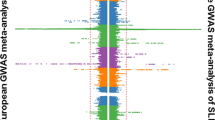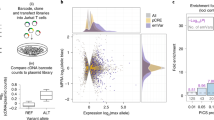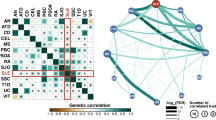Abstract
Systemic lupus erythematosus is an autoimmune disease in which complex interactions between genes and environmental factors determine the disease phenotype. We have shown that genes from the non-autoimmune strains 129 and C57BL/6 (B6), commonly used for generating gene-targeted animals, can induce a lupus-like disease. Here, we conducted a genome-wide scan analysis of a cohort of (129 × B6)F2 C1q-deficient mice to identify loci outside the C1qa locus contributing to the autoimmune phenotype described in these mice. The results were then confirmed in a larger dataset obtained by combining the data from the C1q-deficient mice with data from previously reported wild-type mice. Both analyses showed that a 129-derived interval on distal chromosome 1 is strongly linked to autoantibody production. The B6 genome contributed to anti-nuclear autoantibody production with an interval on chromosome 3. Two regions were linked to glomerulonephritis: a 129 interval on proximal chromosome 7 and a B6 interval on chromosome 13. These findings demonstrate that interacting loci between 129 and B6 mice can cause the expression of an autoimmune phenotype in gene-targeted animals in the absence of any disrupted gene. They also indicate that some susceptibility genes can be inherited from the genome of non-autoimmune parental strains.
This is a preview of subscription content, access via your institution
Access options
Subscribe to this journal
Receive 6 digital issues and online access to articles
$119.00 per year
only $19.83 per issue
Buy this article
- Purchase on Springer Link
- Instant access to full article PDF
Prices may be subject to local taxes which are calculated during checkout







Similar content being viewed by others
Abbreviations
- Abs:
-
antibodies
- AEU:
-
arbitrary ELISA units
- ANA:
-
antinuclear antibody
- AP:
-
alkaline phosphatase
- anti-dsDNA:
-
anti-double stranded DNA
- anti-ssDNA:
-
anti-single stranded DNA
- B6:
-
C57BL/6
- GN:
-
glomerulonephritis
- QTL:
-
quantitative trait locus
- SLE:
-
Systemic lupus erythematosus
References
Wakeland EK, Liu K, Graham RR, Behrens TW . Delineating the genetic basis of systemic lupus erythematosus. Immunity 2001; 15: 397–408.
Obata Y, Tanaka T, Stockert E, Good RA . Autoimmune and lymphoproliferative disease in (B6-GIX+ X 129)F1 mice: relation to naturally occurring antibodies against murine leukemia virus-related cell surface antigens. Proc Natl Acad Sci USA 1979; 76: 5289–5293.
Botto M, Dell'Agnola C, Bygrave AE, Thompson EM, Cook HT, Petry F et al. Homozygous C1q deficiency causes glomerulonephritis associated with multiple apoptotic bodies. Nat Genet 1998; 19: 56–59.
Bickerstaff MC, Botto M, Hutchinson WL, Herbert J, Tennent GA, Bybee A et al. Serum amyloid P component controls chromatin degradation and prevents antinuclear autoimmunity. Nat Med 1999; 5: 694–697.
Santiago-Raber ML, Lawson BR, Dummer W, Barnhouse M, Koundouris S, Wilson CB et al. Role of cyclin kinase inhibitor p21 in systemic autoimmunity. J Immunol 2001; 167: 4067–4074.
Bygrave AE, Rose KL, Cortes-Hernandez J, Warren J, Rigby RJ, Cook HT et al. Spontaneous autoimmunity in 129 and C57BL/6 mice-implications for autoimmunity described in gene-targeted mice. PLoS Biol 2004; 2: E243.
Drake CG, Rozzo SJ, Hirschfeld HF, Smarnworawong NP, Palmer E, Kotzin BL . Analysis of the New Zealand Black contribution to lupus-like renal disease. Multiple genes that operate in a threshold manner. J Immunol 1995; 154: 2441–2447.
Vyse TJ, Rozzo SJ, Drake CG, Izui S, Kotzin BL . Control of multiple autoantibodies linked with a lupus nephritis susceptibility locus in New Zealand black mice. J Immunol 1997; 158: 5566–5574.
Morel L, Blenman KR, Croker BP, Wakeland EK . The major murine systemic lupus erythematosus susceptibility locus, Sle1, is a cluster of functionally related genes. Proc Natl Acad Sci USA 2001; 98: 1787–1792.
Hogarth MB, Slingsby JH, Allen PJ, Thompson EM, Chandler P, Davies KA et al. Multiple lupus susceptibility loci map to chromosome 1 in BXSB mice. J Immunol 1998; 161: 2753–2761.
Haywood ME, Hogarth MB, Slingsby JH, Rose SJ, Allen PJ, Thompson EM et al. Identification of intervals on chromosomes 1, 3, and 13 linked to the development of lupus in BXSB mice. Arthritis Rheum 2000; 43: 349–355.
Izui S, Kelley VE, Masuda K, Yoshida H, Roths JB, Murphy ED . Induction of various autoantibodies by mutant gene lpr in several strains of mice. J Immunol 1984; 133: 227–233.
Izui S, Higaki M, Morrow D, Merino R . The Y chromosome from autoimmune BXSB/MpJ mice induces a lupus-like syndrome in (NZW × C57BL/6)F1 male mice, but not in C57BL/6 male mice. Eur J Immunol 1988; 18: 911–915.
Merino R, Shibata T, De Kossodo S, Izui S . Differential effect of the autoimmune Yaa and lpr genes on the acceleration of lupus-like syndrome in MRL/MpJ mice. Eur J Immunol 1989; 19: 2131–2137.
Bolland S, Ravetch JV . Spontaneous autoimmune disease in Fc(gamma)RIIB-deficient mice results from strain-specific epistasis. Immunity 2000; 13: 277–285.
Mitchell DA, Pickering MC, Warren J, Fossati-Jimack L, Cortes-Hernandez J, Cook HT et al. C1q deficiency and autoimmunity: the effects of genetic background on disease expression. J Immunol 2002; 168: 2538–2543.
Pickering MC, Botto M, Taylor PR, Lachmann PJ, Walport MJ . Systemic lupus erythematosus, complement deficiency, and apoptosis. Adv Immunol 2000; 76: 227–324.
Bolland S, Yim Y-S, Tus K, Wakeland EK, Ravetch JV . Genetic modifiers of systemic lupus erythematosus in FcγRIIB−/− mice. J Exp Med 2002; 195: 1167–1174.
Rozzo SJ, Vyse TJ, Drake CG, Kotzin BL . Effect of genetic background on the contribution of New Zealand black loci to autoimmune lupus nephritis. Proc Natl Acad Sci USA 1996; 93: 15164–15168.
Morel L, Tian XH, Croker BP, Wakeland EK . Epistatic modifiers of autoimmunity in a murine model of lupus nephritis. Immunity 1999; 11: 131–139.
Wandstrat AE, Nguyen C, Limaye N, Chan AY, Subramanian S, Tian XH et al. Association of extensive polymorphisms in the SLAM/CD2 gene cluster with murine lupus. Immunity 2004; 21: 769–780.
Morel L, Rudofsky UH, Longmate JA, Schiffenbauer J, Wakeland EK . Polygenic control of susceptibility to murine systemic lupus erythematosus. Immunity 1994; 1: 219–229.
Kono DH, Burlingame RW, Owens DG, Kuramochi A, Balderas RS, Balomenos D et al. Lupus susceptibility loci in New Zealand mice. Proc Natl Acad Sci USA 1994; 91: 10168–10172.
Vidal S, Kono DH, Theofilopoulos AN . Loci predisposing to autoimmunity in MRL-Fas lpr and C57BL/6-Faslpr mice. J Clin Invest 1998; 101: 696–702.
Xie S, Chang SH, Sedrak P, Kaliyaperumal A, Datta SK, Mohan C . Dominant NZB contributions to lupus in the (SWR × NZB)F1 model. Genes Immun 2002; 3 (Suppl 1): S13–S20.
Kikuchi S, Fossati-Jimack L, Moll T, Amano H, Amano E, Ida A et al. Differential role of three major New Zealand Black-derived loci linked with Yaa-induced murine lupus nephritis. J Immunol 2005; 174: 1111–1117.
Takeuchi O, Fisher J, Suh H, Harada H, Malynn BA, Korsmeyer SJ . Essential role of Bax, Bak in B cell homeostasis and prevention of autoimmune disease. Proc Natl Acad Sci USA 2005; 102: 11272–11277.
Burlingame RW, Rubin RL . Subnucleosome structures as substrates in enzyme-linked immunosorbent assays. J Immunol Methods 1990; 134: 187–199.
Manly KF, Olson JM . Overview of QTL mapping software and introduction to map manager QT. Mammlian Genome 1999; 10: 327–334.
Lander E, Kruglyak L . Genetic dissection of complex traits: guidelines for interpreting and reporting linkage results. Nat Genet 1995; 11: 241–247.
Acknowledgements
We thank Mrs Margarita Lewis for technical assistance with the processing of tissue for histological studies and the staff of the Biological Services Unit at our institution for the care of the animals involved in this study. This work was supported by the Wellcome Trust (Grant number 071467).
Author information
Authors and Affiliations
Corresponding author
Rights and permissions
About this article
Cite this article
Heidari, Y., Bygrave, A., Rigby, R. et al. Identification of chromosome intervals from 129 and C57BL/6 mouse strains linked to the development of systemic lupus erythematosus. Genes Immun 7, 592–599 (2006). https://doi.org/10.1038/sj.gene.6364335
Received:
Accepted:
Published:
Issue Date:
DOI: https://doi.org/10.1038/sj.gene.6364335



